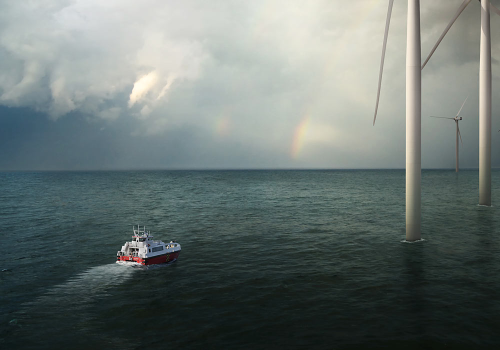
In Part 1 of this feature we reviewed some of the companies choosing composites to manufacture wind farm service vessels (WFSVs). In Part 2 we ask if composite vessels can withstand conditions for offshore.
Inshore limitation?
Not everyone is convinced that composite craft can ‘cut it’ as wind farm development migrates further offshore.
As one industry insider told Reinforced Plastics: “I believe that composite craft are best suited for wind farms that are relatively close to shore and for operation in significant wave heights of up to a metre. It seems to me that only metal can survive the hard knocks that craft will experience further offshore where conditions are harsher. In general, aluminium is malleable and dents but composites fracture and fragment so that repairing a composite boat after a knock takes much longer.”
Our informant cited the case of a glass reinforced plastic (GRP) catamaran that had hit a wind turbine at 6 knots, resulting in severe damage including separation of many internal frames from the hull as the structure deformed momentarily. Prolonged repairs meant that the vessel was out of service for three months. He compared this with the case of an aluminium catamaran that had hit a monopile at some 20 knots. Despite a severely dented hull, the craft made its own way back to base and repairs were completed within a couple of weeks.
This chimes with the experience of South Boats, the Isle of Wight, UK-based boat builder that constructs about 25 wind farm crew transfer vessels per year and has craft up to 28 m in production. According to sales and technical director Ben Colman, the company produces ten times as many metal craft as composite.
Nevertheless, the company’s GRP catamaran service vessels are still sought after and their manufacture has recently been taken back in house, after a period during which it was out-sourced. Production now takes place in the company’s Medina Yard at Cowes.
Hulls and decks are fabricated by conventional wet lay-up in female moulds, although a number of internal mouldings and consoles are resin infused to save weight. Woven multiaxial fabrics are used along with high-specification resins including isophthalic polyester. Structural rigidity is achieved by moulding or bonding into the single-skin laminate a generous complement of GRP-skinned/structural foam stringers, transverse frames and bulkheads.
South vessels have gained a reputation for outstanding sea keeping and ability to maintain high service speeds in rough seas. Recent examples of GRP craft delivered for wind farm use include 13 m RRVs (rapid response vessels) for Iceni Marine Services, operating out of Great Yarmouth, UK. Construction of a fifth vessel for this operator, Iceni Pride, is now underway at South Boats Special Projects at Cowes.
A recent announcement that the Isle of Wight company is being acquired by Alicat Workboats will not, declares Ben Colman, lead to any production cut-backs or redundancies since there are a healthy order book, enquiry pipeline and a fast-developing WFSV market to be exploited. The acquisition does, however, ease immediate cash flow pressures and will permit new investment to be made in further expansion.
Assertions that composite vessels are not up to the tough demands of wind farm service well offshore are contradicted by activity elsewhere in the sector. As one example, Norfolk-based start-up operator Tidal Transit Ltd has ordered a new offshore WFSV from the Mercurio Plastics Shipyard in Cartagena, Spain. The £1.5 million GRP-constructed Tia Elizabeth, due to be delivered next March, will be capable of working up to 150 miles from shore (MCA Category 1 code) making it suitable for supporting UK Round 3 wind farm projects. The craft is being built to the same specification as two existing vessels, Ginny Louse and Eden Rose, also produced by Mercurio Plastics. Tidal Transit is aiming to have ten such vessels in due course, serving wind farms throughout the North Sea.
Being sizeable vessels, at 28 m LOA, and with an innovative hull design aimed at reducing slamming and motion in short wavelengths at sea, the craft are able to operate in higher sea states than most competitors. The design was recently approved by Scottish and Southern Electricity (SSE) to carry out personnel transfers in significant wave heights (Hs) of up to 2 m, beating the current 1.5 m industry norm. This ability benefits O&M efficiency by increasing the time available to carry out repairs and maintenance. With on-board facilities that include high-comfort seating, a galley and sleeping accommodation for four crew and 12 passengers, the Tidal Transit craft can stay out for several days at a time, enabling maintenance crews to service multiple turbines per trip. Each craft can also carry an on-board crane and up to 10 tonnes of cargo. ♦
This article is an excerpt from the feature Opportunities for compositersd in wind farm service vessels published in the November/December 2012 issue of Reinforced Plastics magazine. Part 1 of the feature is available here. Part 3 will be available soon.
The digital edition of Reinforced Plastics is distributed free of charge to readers who meet our qualifying criteria. You can apply to receive your free copy by completing the registration form.






